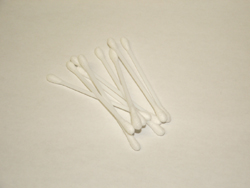Thermal Paste and How To Use It |
|
Choosing the right thermal paste
When choosing a paste for your heatsink, you have two main types that are usually considered; metal-based or ceramic-based. In most cases people use the metal-based, simply because it performs better as stated before. But nowadays, especially with GPUs, there are a lot of transistors/electrical components that are very close to the die.So when applying thermal paste, if you are not very experienced with applying it, there is a chance that when you place the heatsink, some of the paste can be squeezed out onto theses transistors/electrical components and cause a short. This is very bad of course and is a nightmare for anyone.
This is where a ceramic-based compound has the advantage. With RAM module heatsinks, ceramic-based is almost a given to use. GPUs and chipsets are also examples that you might want to use a ceramic paste on, unless you are comfortable with using metal-based. But do not use a metal-based paste on RAM. Metal-based is usually used on CPUs that have an Integrated Heat Spreader (IHS). All modern CPUs have an IHS, but some people will actually remove it to get better performance.
For brands of thermal paste, the best around are Arctic Silver, Arctic Cooling, Coollaboratory, and a few others. They make very high quality thermal materials that are the most used by end-users. You can't go wrong with these brands. Other makes will work great, but maybe not as good. For the few extra dollars that are needed for some of the more expensive brands is usually worth it.

Cleaning your chip first
If you’re installing a new heatsink before you even had a heatsink on you CPU, then there is no need to do this. But in the case of putting a new one on, or changing a video card cooler, then you must clean your chip first.For this, most used is Isopropyl Alcohol, Acetone, or a solution called ArctiClean. For using the cleaners, use non-linty cloth or Q-Tips (cotton swabs). Q-Tips are great where they're small and easy to get where you want, plus you can also see exactly what you are doing.

For Isopropyl Alcohol, the higher the percentage the better. 70% is not bad, 90% or higher is the most ideal. The reason; the higher the percentage, the quicker it will evaporate and the less residue it will leave. 99% will leave almost zero residue.


Note: Never use any oil-based cleaners, as oil will ruin your coolers performance because it adds an oil layer through which heat travels slowly.
When you have your cleaner, dip your cloth/Q-Tip in, then gently rube the surface of the chip until all the old paste is gone. You will probably have to do this more than once to get it nice and clean. It is usually a good idea to use a credit card to scrape most of the old TIM off, and then use the cleaners.



The exact same process is used to clean the CPU/GPU. Just be careful if you're cleaning the CPU out of it’s socket. If you push to hard on it, you might bend a pin.
Note: Make sure you do not touch the surface of the chip with your bare finger, as your skin has natural oils on it as well.
To remove thermal pads, use a credit card or some other plastic object (do not use a metal object as it could scratch the cooler's base). Then follow the same procedure as stated above. You want to make sure all of the old paste or thermal pad is gone, otherwise it can affect performance of the cooler.
Mar 4th, 2025 01:54 EST
change timezone
Latest GPU Drivers
New Forum Posts
- The future of RDNA on Desktop. (32)
- 3DMARK "LEGENDARY" (273)
- Found a weird Radeon HD 7950 with 1536 shaders and no temperature readout (28)
- Easy to open wired mice (7)
- High-end build in the 2025 mad world situation (13)
- Was pentium 4 an over engineered CPU? (95)
- What's your latest tech purchase? (23234)
- Authenticode fails for GPU-Z 2.63.0 (20)
- It's happening again, melting 12v high pwr connectors (994)
- GameTechBench GPU benchmark is already out! (292)
Popular Reviews
- AMD Radeon RX 9070 Series Technical Deep Dive
- ASUS GeForce RTX 5070 Ti TUF OC Review
- be quiet! Pure Base 501 DX Review
- AMD Ryzen 7 9800X3D Review - The Best Gaming Processor
- MSI GeForce RTX 5070 Ti Vanguard SOC Review
- RAWM ES21M Review
- EIZO FlexScan EV4340X Review - A Multitasking Powerhouse
- ASUS ROG Harpe Ace Mini Review
- MSI GeForce RTX 5070 Ti Ventus 3X OC Review
- MSI GeForce RTX 5070 Ti Gaming Trio OC+ Review
Controversial News Posts
- NVIDIA GeForce RTX 50 Cards Spotted with Missing ROPs, NVIDIA Confirms the Issue, Multiple Vendors Affected (513)
- AMD Plans Aggressive Price Competition with Radeon RX 9000 Series (274)
- AMD Radeon RX 9070 and 9070 XT Listed On Amazon - One Buyer Snags a Unit (260)
- AMD Mentions Sub-$700 Pricing for Radeon RX 9070 GPU Series, Looks Like NV Minus $50 Again (248)
- NVIDIA Investigates GeForce RTX 50 Series "Blackwell" Black Screen and BSOD Issues (244)
- AMD RDNA 4 and Radeon RX 9070 Series Unveiled: $549 & $599 (230)
- AMD Radeon RX 9070 and 9070 XT Official Performance Metrics Leaked, +42% 4K Performance Over Radeon RX 7900 GRE (195)
- AMD Radeon RX 9070-series Pricing Leaks Courtesy of MicroCenter (158)